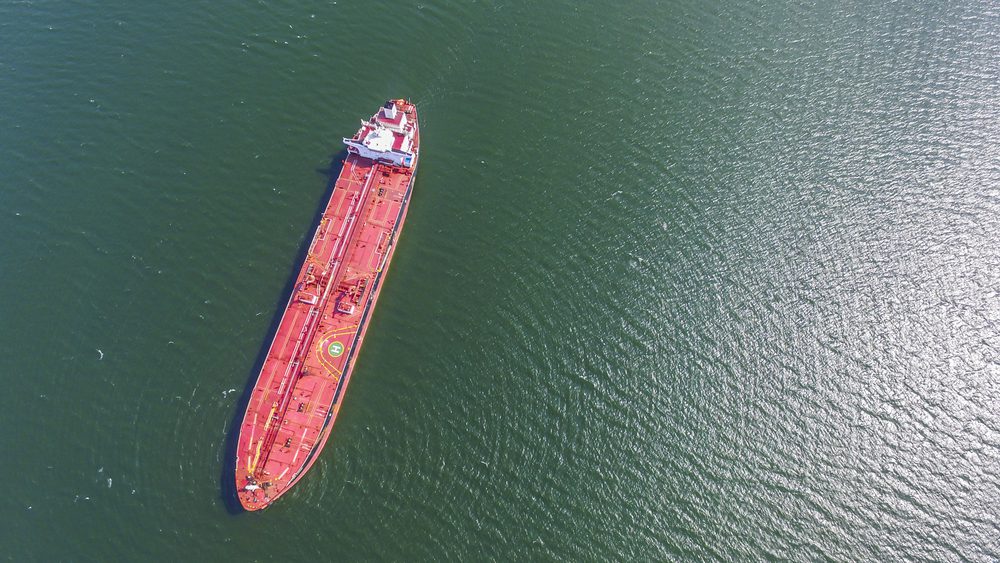Photo: By angelstructure / Shutterstock
By Serene Cheong and Alfred Cang (Bloomberg) — The world’s biggest offshore oil supermarket is stocking up for anti-pollution rules that Goldman Sachs Group Inc. predicts will upend energy markets.
The Strait of Malacca off Singapore and Malaysia is not only a waterway linking supply from the Middle East, Africa and the U.S. to Asia, but has also been used in the past decade to store millions of barrels of oil for future sales. Now, with new ship-emission regulations taking effect in 2020, traders are using the channel to hoard fuels for which demand will boom.
Some of the top trading houses are beginning to gather a fleet of tankers to receive, store and resell products such as low-sulfur fuel oil, diesel and light-cycle oil in what would effectively be a mini supply and distribution hub out at sea. That’s ahead of Jan. 1, when International Maritime Organization rules will require ships worldwide to stop burning dirty fuel and use relatively cleaner supply.
“In the coming months, we could see a flexible, low-cost floating tank farm in the Strait of Malacca,” said Anoop Singh, an analyst at shipbrokering firm Braemar ACM. “We expect to see a whole fleet of tankers off Singapore and Malaysia taking part in a low-sulfur oil blending play that will also be found off other major ports such as Fujairah and Rotterdam.”
At least five vessels are currently anchored near Singapore with low-sulfur fuel oil and other blending components as of April 19, according to shipping intelligence firm Kpler SAS. They consist of long-range tankers, very large crude carriers and floating storage and offloading vessels that can each hold about 700,000 to 2 million barrels. Charterers include Japan’s Mitsui & Co. and Germany’s Uniper SE, shipbrokers and traders said.
Trader Rush
More will probably join them as other traders get in on the action. Five supertankers have been hired by Vitol Group, Gunvor Group Ltd., Litasco SA and Trafigura Group for storage off Singapore, according to Asian shipbrokers, who asked not to be identified as the information is confidential. The companies booked the vessels for time-charters of up to three months beginning this quarter.
Press officers for Vitol, Gunvor, Litasco and Trafigura declined to comment. Mitsui and Uniper couldn’t immediately comment.
It’s unlikely the tankers will be taking part in a so-called contango play — a strategy that’s commonplace when weak market conditions and cheap crude cargoes prompt traders to store shipments for future sales at higher prices. That’s because futures for Brent, West Texas Intermediate and Dubai oil are now in backwardation, when near-term contracts are costlier than those for later.
Instead, it’s more likely that VLCCs Good News, New Tinos, DF Commodore, Ridgebury Progress and Cosbright Lake will be used to hold low-sulfur oil blendstocks, according to shipbrokers and traders. They are currently moored or anchored off Singapore and the west coast of Malaysia, according to Bloomberg ship-tracking data.
“Oil traders are hoarding low-sulfur oil components in the hope that prices of compliant fuels will blow out in six to nine months’ time when new IMO rules kick in,” said Nevyn Nah, the head of east of Suez products at industry consultant Energy Aspects Ltd.
Come Jan. 1, the global shipping fleet will need to stop being powered by fuel with 3 percent or higher sulfur content — the current industry norm — in favor of cleaner fuel. While they can also install pollution-reducing kits, a long waiting list for the specialized equipment known as scrubbers means tanker operators are set to use a lot more oil that has sulfur content of 0.5 percent or lower.
The new regulations will prove a big challenge for both the shipping and refining industries, and roil returns from turning crude into petroleum, Goldman Sachs said in an April 25 note detailing themes that will dominate commodity markets in coming months. The rules will provide support to distillates such as diesel, which will “abruptly” become the tanker fuel of choice, according to the bank.
To meet demand, some vessels that were previously used by traders for supplying ships or power plants will now probably be used to store low-sulfur blending components. Mitsui, for example, is expected to use Energy Star for 0.5 percent sulfur fuel that’s compliant with new IMO standards, ship-tracking firm Vortexa Ltd. said in an April 12 note, moving away from handling oil for Japan’s utility market.
“There’s a fear of missing out on this trade,” Nah of Energy Aspects said.
© 2019 Bloomberg L.P

 Join The Club
Join The Club











